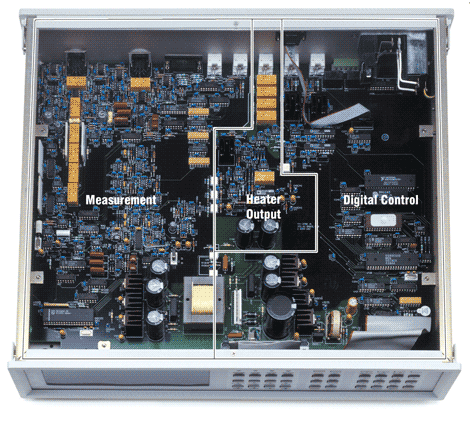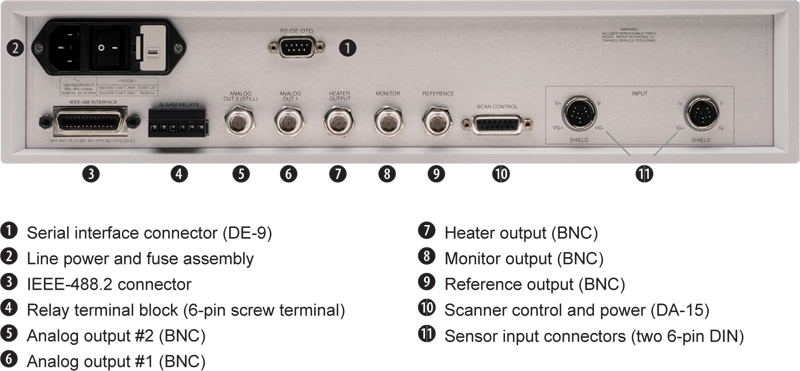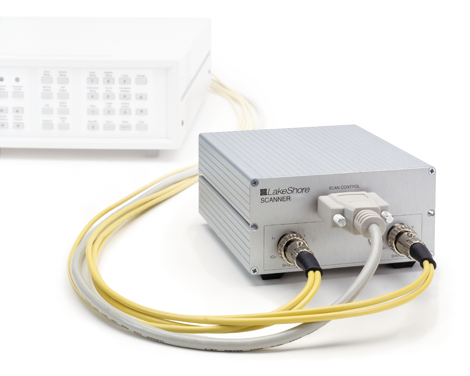More about the Model 370
Resistance measurement
With the same attention to precision and detail that helped Lake Shore become the world leader in subkelvin temperature sensors, the Model 370 AC resistance bridge combines a full range of design strategies which optimize resolution and minimize measurement uncertainty in low power resistance measurement.
The Model 370 uses 4-lead AC measurement for the best possible accuracy with the lowest possible excitation current. AC coupling at each amplifier stage reduces offsets for higher gain and greater sensitivity than DC techniques allow. Phase sensitive detection, an AC filtering technique used in lock-in amplifiers, reclaims small measurement signals from environmental noise. A low excitation frequency of 13.7 Hz reduces the effect of lead capacitance on measurement. These features, in conjunction with innovative lead shielding and active noise reduction circuitry, significantly reduce measurement noise and resistor self-heating.
The Model 370 current excitation source provides stable, reliable, low power excitation current. Twenty-one AC current levels from 3.16 pA to 31.6 mA RMS offer low noise with no significant DC component to contribute to sensor self-heating. Two operating modes provide excitation control options to meet user and application needs.
Performance enhancement
Innovative features enhance the performance of the Model 370 from excitation to output. Common mode voltage can come from many sources, including external noise coupling into the lead wires. The Model 370 provides a unique, patented, matched impedance current source as its first defense against common mode noise. Just as voltage input terminals for a differential input have the same input impedance, the two current source output terminals of the Model 370 have the same source impedance. This matched impedance ensures that common mode voltages do not become normal mode voltages. With this strategy, the differential input remains truly differential for accurate resistance measurement.
To further reduce the effect of common mode voltage, the Model 370 includes an active common mode reduction circuit. This circuit dynamically adjusts the current source output operation point to minimize common mode voltage at the measurement input. Active common mode reduction allows the Model 370 to operate in environments that would otherwise saturate the differential input amplifiers.
Optocouplers isolate the analog front end of the Model 370 from digital circuitry and the instrument chassis. Optical isolation minimizes the effect of digital noise on the measurement and breaks ground loops.
For applications where lead length is greater than 10 ft, or resistance is greater than 100 kΩ, the Model 370 also includes four separate driven guards that follow the voltage on each lead to provide the lowest possible voltage difference between the lead and its shield. Driven guards reduce the effect of cable capacitance and provide the best possible shielding. Driven guards are not available for scanned inputs.
To accommodate conversion of changing output from phase sensitive detection to a stable signal, the Model 370 operates with a 200 ms minimum filter time constant. While this is adequate for measurement of small resistance values with large excitation, the Model 370 software provides additional filtering to ensure good resolution as resistance increases and excitation decreases. Linear filtering or averaging offers the best possible settling time, with selections from 1 s to 200 s.
Excitation modes
The Model 370 provides full scale resistance ranges from 2 mΩ to 2 MΩ. The selected resistance range is continuously displayed; excitation power dissipated in the resistor is also continuously calculated and displayed.
The Model 370 includes both a current excitation mode and a voltage mode for resistor excitation. Current excitation is the instrument's primary mode of operation. In current mode, the Model 370 provides the appropriate voltage gain when the resistance range and a fixed excitation current are selected. The instrument changes gain when the resistance range is changed. In current mode, the actual excitation current is continuously displayed.
In voltage mode, the Model 370 firmware simulates voltage excitation. In voltage mode, the instrument changes the current to maintain the voltage limit when the resistance range is changed. Because voltage is limited in voltage mode, excitation power decreases as resistance increases, and temperature decreases when negative temperature coefficient (NTC) resistance materials are measured. As a result, voltage mode provides a convenient way to limit excitation power and resistor self-heating for NTC resistance temperature sensors. In voltage mode, the upper input voltage limit but not the actual voltage is continuously displayed.
Autorange and manual range
The autorange and manual range selection functions of the Model 370 are available for use with both current excitation mode and voltage mode. The autorange function increases or decreases the resistance range when measured resistance exceeds or falls below the range in use. In current mode, the autorange function modifies the voltage gain. In voltage mode, autorange modifies the current setting.
Manual range selection provides the option of full user control. With manual range selection, the user selects excitation as well as resistance range; ranges do not change automatically. If input resistance exceeds the range, an overload message appears. With both autorange and manual range selection, the excitation current source is shorted inside the Model 370 during range changes to minimize transients.

Temperature conversion
The temperature conversion function of the Model 370 converts measured resistance to temperature for calibrated resistance thermometers. Temperature as well as resistance values can be displayed; temperature and resistance values are also available for interface query. Conversion is based on temperature response curve data loaded into the instrument for each calibrated resistance thermometer in use. Up to twenty 200-point curves can be entered into nonvolatile memory via computer interface or the instrument front panel. Lake Shore CalCurves™ are available for Lake Shore calibrated sensors; users can also generate their own curves as desired.
Temperature control
The Model 370 provides all of the circuitry and software for digital proportional-integral-derivative (PID) control. Heater output is a variable DC current source with multiple power ranges from 0.1 µ W to 1 W to drive a resistive heater (nominal 100 Ω). Heater output is designed for low noise, with circuits to eliminate power surges during range changes or at instrument start-up. A still heater function can also supply up to 1 W of power into a still heater load (nominal 100 Ω) by way of one of the instrument's analog outputs to enhance temperature control. The best control stability is achieved using only one sensor, but the Model 370 can control temperature based on one of multiple scanned sensors. Because the Model 370 alternates control with scanned sensor readings and the alternating update rate is slower than operation based on a single sensor, control stability may degrade in some systems when multiple sensors are in use.
Computer interfaces
The Model 370 includes IEEE-488.2 parallel and RS-232C serial interfaces. Both use the instrument chassis as ground, while measurement input is optically isolated from the chassis to minimize interface noise and ground loops. Both interfaces can accommodate data transmission at the maximum reading rate of the Model 370 for automated data recording. All instrument parameters, all available status information, and almost every instrument function, including analog voltage outputs and relays, can be accessed by computer interface.
Analog outputs
With two analog voltage outputs and two relays, the Model 370 can perform functions that might otherwise require additional hardware and system complexity. Configured for use as resistance monitors, the analog voltage outputs provide a voltage proportional to measured resistance that can be used to monitor resistance error (ΔR), temperature, or temperature error. Analog outputs can be controlled manually from the front panel, by computer interface, and for some functions, by the internal operating modes of the Model 370. Closed loop control is not available for analog output functions.
Configurable display
The Model 370 includes an eight line by forty character vacuum fluorescent display. Input readings can be displayed in mΩ, Ω, kΩ , MΩ , mK, or K.

Scanners for Model 370
Two custom scanners are available with the Model 370, the Model 3716 and the Model 3708. These are designed specifically to increase the Model 370 input capability from 1 to either 8 or up to 16 resistors without sacrificing measurement performance.
Each scanner is housed in a separate enclosure and can be mounted directly on the cryostat so leads carrying the most sensitive low voltage signals are as short as possible. The scanner also allows extension of the Model 370 shield to all resistor leads. A preamplifier in the scanner amplifies measurement signals before they travel through the longer leads to the Model 370. Different preamplifiers in the 3716 and 3708 optimize them for different applications. The Model 370 supplies power and control to the scanner, eliminating additional noise from AC power lines, ground loops, and computer interface connections.
Scanner operation is fully integrated so most of the Model 370 hardware and firmware features can be used with the scanner. Supported hardware features include matched impedance current source and ground isolation. The scanners provide four 25-pin D-sub connectors for resistance inputs. Each connector accommodates four inputs, with four signal and two shield lines for each input. Guarding is supported between the instrument and scanner only. Interface cables from the Model 370 to the scanner are included with the scanner.
Supported firmware features include temperature conversion, math functions, linear equations, and in some applications, temperature control. The Model 370 can store measurement range and temperature conversion data for each resistor. Appropriate parameter values are automatically recalled with input changes, reducing interface overhead and settling time. As with any scanner, the resistance reading rate is slower during input changes, resulting in longer filter settling times and a longer sample period for temperature control. The Model 370 can be used with third party scanners; however, access to integrated features is lost.
The Model 3716 scanner
The Model 3716 mirrors the single input of the Model 370 that is optimized for low residual DC bias current. Low bias provides the lowest available resistor self-heating when excitation currents are in the range of 1 pA to 30 pA. It also provides the best available accuracy when resistances are above 200 kΩ. The tradeoff for these performance features is a slightly greater noise figure (33 nV/√Hz) than the Model 3716L. Unused leads are connected to measurement common to reduce noise pickup, a persistent problem when measuring large resistances. Performance of the Model 3716 scanner is so nearly identical to the Model 370 that they share specifications for resistance range, accuracy, and resolution (noise).
The Model 3708 ultra-low resistance preamp/scanner
For ultra-low AC resistance measurement applications that demand the very best in low noise performance, the Model 3708 8-channel preamp/scanner is the best choice. At just 2 nVRMS/√Hz, the Model 3708 offers the lowest input voltage noise of the three available scanners and can achieve measurement resolution to 10 nΩ. The Model 3708 has unused leads that are left open to facilitate Hall effect measurement sequencing. With DC bias current of 50 pA, however, it is not recommended for subkelvin temperature measurements. These measurements require very low DC bias current to prevent measurement errors as a result of self heating. Specifications for resistance range, accuracy, and resolution (noise) are different than the standalone Model 370.


